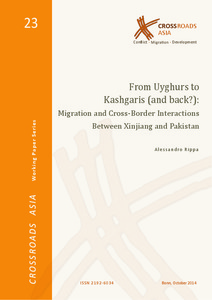From Uyghurs to Kashgaris (and back?): Migration and Cross-Border Interactions Between Xinjiang and Pakistan

From Uyghurs to Kashgaris (and back?): Migration and Cross-Border Interactions Between Xinjiang and Pakistan

| dc.contributor.author | Rippa, Alessandro | |
| dc.contributor.editor | Baldauf, Ingeborg | |
| dc.contributor.editor | Conermann, Stephan | |
| dc.contributor.editor | Kreutzmann, Hermann | |
| dc.contributor.editor | Nadjmabadi, Shahnaz | |
| dc.contributor.editor | Reetz, Dietrich | |
| dc.contributor.editor | Schetter, Conrad | |
| dc.contributor.editor | Sökefeld, Martin | |
| dc.contributor.editor | Hornidge, Anna-Katharina | |
| dc.date.accessioned | 2016-10-05T15:08:10Z | |
| dc.date.available | 2016-10-05T15:08:10Z | |
| dc.date.issued | 10.2014 | |
| dc.identifier.uri | https://hdl.handle.net/20.500.11811/156 | |
| dc.description.abstract | China and Pakistan share a common border, formally established in 1963, and a close friendship which, to a certain extent, is a direct consequence of that agreement. Somewhat surprisingly the two countries managed to maintain - and even improve - their friendly ties in spite of several events which might have undermined the basis of their friendship. In particular, since September 11, 2001, China has condemned various incidents in its Muslim province of Xinjiang as connected to the global jihad, often holding Pakistan-based Uyghur militants responsible and accusing Islamabad of not doing enough to prevent violence from spreading into Chinese territory. Within a scenario of growing insecurity for the whole region, in this paper I show how China’s influence in Pakistan goes well beyond the mere government-to-government level. Particularly, I address the hitherto unstudied case of the Uyghur community of Pakistan, the Kashgaris, a group of migrants who left Xinjiang over the course of the last century. This paper, based on four months of fieldwork in Pakistan, aims principally at offering an overview of the history and current situation of the Uyghur community of Pakistan. It thus first examines the migration of the Uyghur families to Pakistan according to several interviews with elder members of the community. Secondly, it addresses some recent developments within the community, and focuses particularly on the influence China is exercising over it since the creation of the Overseas Chinese Association in 2003. Eventually, it suggests that since the opening of the Karakoram Highway in 1982 a variety of factors - among which figures primarily this recent Chinese interest - have caused an important political divide within the community, and brought to a re-definition of the Kashgaris’ identity vis-à-vis both Xinjiang and Pakistan. | en |
| dc.format.extent | 30 | |
| dc.language.iso | eng | |
| dc.relation.ispartofseries | Crossroads Asia Working Paper Series ; 23 | |
| dc.rights | In Copyright | |
| dc.rights.uri | http://rightsstatements.org/vocab/InC/1.0/ | |
| dc.subject | Migration | |
| dc.subject | Xinjiang | |
| dc.subject | Pakistan | |
| dc.subject.ddc | 320 Politik | |
| dc.title | From Uyghurs to Kashgaris (and back?): Migration and Cross-Border Interactions Between Xinjiang and Pakistan | |
| dc.type | Arbeitspapier | |
| dc.publisher.name | Competence Network Crossroads Asia: Conflict – Migration – Development | |
| dc.publisher.location | Bonn | |
| dc.rights.accessRights | openAccess | |
| dc.relation.eissn | 2192-6034 | |
| dc.relation.url | http://crossroads-asia.de/veroeffentlichungen/working-papers.html | |
| ulbbn.pubtype | Zweitveröffentlichung |
Dateien zu dieser Ressource
Das Dokument erscheint in:
-
Crossroads Asia Working Paper Series (37)
Working Paper des Kompetenz-Netzwerks Crossroads Asia




